

NIH Curriculum Supplement Series for High School - The Brain: Understanding Neurobiology Through the Study of Addiction. The Science of Mental Illness. : BioMath. Quorum Sensing: Organisms Communicating and Coordinating We live in an ever-changing world.

Many people crave information about those changes. As a result, new means of communicating are continually evolving. > Brain Hemisphere Hat (made of paper) This is the “world-famous” Brain Hat.
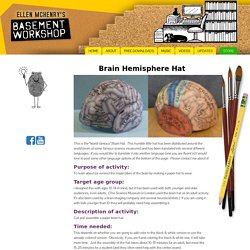
This humble little hat has been distributed around the world (even at some famous science museums) and has been translated into several different languages. If you would like to translate it into another language (one you are fluent in) I would love to post some other language options at the bottom of this page. Please contact me about it! “Ectomy” (a game about the brain) Purpose of the game: To learn (or review) information about the lobes of the brain and what they do.
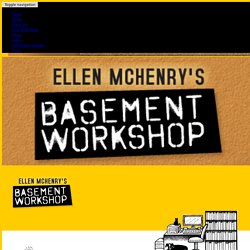
These lobes are: frontal, temporal, occipital, parietal, sensory cortex and motor cortex. Description of game: Each player tries to fill the brain outline with the appropriate lobe parts. Players win parts by answering multiple choice questions. Target age group: > Brain Hemisphere Hat (made of paper) Mouse Party. The Curious Case of Phineas Gage's Brain. Cabinet-card portrait of brain-injury survivor Phineas Gage (1823–1860), shown holding the tamping iron which injured him.
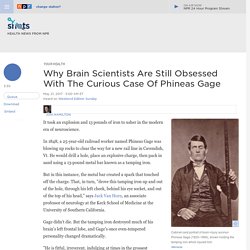
Wikimedia hide caption toggle caption Wikimedia Cabinet-card portrait of brain-injury survivor Phineas Gage (1823–1860), shown holding the tamping iron which injured him. It took an explosion and 13 pounds of iron to usher in the modern era of neuroscience. In 1848, a 25-year-old railroad worker named Phineas Gage was blowing up rocks to clear the way for a new rail line in Cavendish, Vt. Phineas Gage. This article is about the man who survived an iron bar passing through his head.
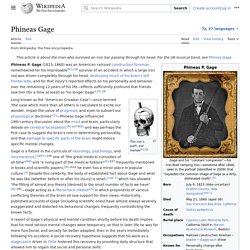
For the UK musical band, see Phinius Gage. Phineas P. Gage (1823 – May 21, 1860) was an American railroad construction foreman remembered for his improbable[B1]:19 survival of an accident in which a large iron rod was driven completely through his head, destroying much of his brain's left frontal lobe, and for that injury's reported effects on his personality and behavior over the remaining twelve years of his life—effects sufficiently profound (for a time at least) that friends saw him as "no longer Gage. " [H]:14. Mike the Headless Chicken. Beheading[edit] On September 10, 1945, farmer Lloyd Olsen of Fruita, Colorado, United States, was planning to eat supper with his mother-in-law and was sent out to the yard by his wife to bring back a chicken.
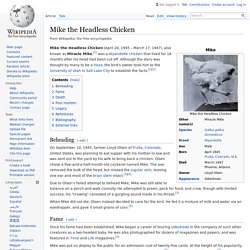
Olsen chose a five-and-a-half-month-old cockerel named Mike. 800L Owww. 1390L Fragile Brains. A Venus Flytrap Works Just Like Your Brain. Updated Brain Map Identifies Nearly 100 New Regions. The first hints of the brain’s hidden geography emerged more than 150 years ago.
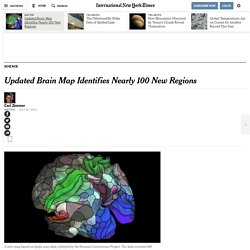
In the 1860s, the physician Pierre Paul Broca was intrigued by two of his patients who were unable to speak. After they died, Broca examined their brains. The more we learn about memory, the weirder it gets. For much of the history of brain science, the word “engram” has been a bit of a catch-all term, referring to the hypothetical physical incarnation of memory.

If this turned out to be a storm of electrical activity, then that’s what the engram would be; if it turned out that networks of physical neurons were the home of specific memories, then an engram was that, instead. Lately, though, the word has gotten a lot more specific. We now have the term “memory neurons” to refer to the nerve cells of the hippocampus, which seem to play a crucial role in storing and retrieving memories. Since the original proof that at least some memory is localized to specific physical neurons just a few short years ago, understanding of the physical basis of memory has advanced at a lightning pace. MIT discovers the location of memories: Individual neurons. Update 12/2/15: We’ve now followed up on this story: The more we learn about memory, the weirder it gets.
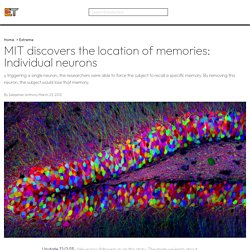
The original continues below. MIT researchers have shown, for the first time ever, that memories are stored in specific brain cells. By triggering a small cluster of neurons, the researchers were able to force the subject to recall a specific memory. By removing these neurons, the subject would lose that memory. This is what happens to the brain during a concussion. The Science of Fear. What are you afraid of?
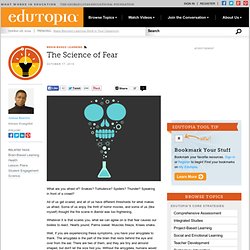
Snakes? Turbulence? Spiders? Thunder? Speaking in front of a crowd? All of us get scared, and all of us have different thresholds for what makes us afraid. Whatever it is that scares you, what we can agree on is that fear causes our bodies to react. Well, if you are experiencing these symptoms, you have your amygdala to thank. Consider the amygdala as your own onboard 911 operator. We can learn quite a lot from animals about how we respond when we are frightened.
Parts of Our Body's Fear System Amygdala: scans for threats and signals body to respond Brain Stem: triggers the freeze response. Nancy'sBrainTalks. On The Move, Hallucinations, Musicophilia, Awakenings, The Man Who Mistook His Wife for a Hat. Here Dr. Sacks recounts the case histories of patients lost in the bizarre, apparently inescapable world of neurological disorders: people afflicted with fantastic perceptual and intellectual aberrations; patients who have lost their memories and with them the greater part of their pasts; who are no longer able to recognize people and common objects; who are stricken with violent tics and grimaces or who shout involuntary obscenities; whose limbs have become alien; who have been dismissed as retarded yet are gifted with uncanny artistic or mathematical talents.
If inconceivably strange, these brilliant tales remain, in Dr. Sacks’s splendid and sympathetic telling, deeply human. They are studies of life struggling against incredible adversity, and they enable us to enter the world of the neurologically impaired, to imagine with our hearts what it must be to live and feel as they do. Neural eng ethical. The NSF Engineering Research Center for Sensorimotor Neural Engineering (CSNE) Traumatic Brain Injury: A Neural Network Journey (DRAFT) Grades: Six to 12 This seven-lesson unit, aimed at middle school and high school students, provides background in neuroanatomy, neuroscience, and neural engineering with a special focus on traumatic brain injury.
The plans were created by Michael Shaw, Cleveland High School (Seattle, Wash.), and Shannon Jephson-Hernandez, Mill Creek Middle School (Kent, Wash.). The unit culminates in a script writing exercise, with students composing a special report on traumatic brain injury. Students will build models, field webquests, conduct research, and take part in hands-on investigations. All lesson plans are aligned to the Washington State K-12 Science Standards, Next Generation Science Standards, and Common Core State Standards. The NSF Engineering Research Center for Sensorimotor Neural Engineering (CSNE)
The NSF Engineering Research Center for Sensorimotor Neural Engineering (CSNE) By Dr. Lise Johnson (CNSE Education Manager) What exactly is Sensorimotor Neural Engineering? That is a very good question, and one that I get asked frequently. Inevitably when you meet someone you get to talking about what you do for a living, and if you work at the Center for Sensorimotor Neural Engineering, it’s only natural for people to wonder what on Earth that is. MacroBrain Interactive Site. Brain Games. Deep Brain Stimulation-Virtual Brain Surgery game. 3D Brain.
NIH Curriculum Supplement Series for High School - The Brain: Understanding Neurobiology Through the Study of Addiction. Neuroscience. Why dread a bump on the head? The neuroscience of traumatic brain injury. This lesson serves as the introduction to the “Why dread a bump on the head?” Unit. Students are introduced to traumatic brain injury (TBI) through pictures and discussions that help students break down prior assumptions and begin to think about TBI from a scientific perspective. Students learn about and discuss the three classifications of TBI, mild, moderate, and severe. These categories are presented through the reading and discussion of news articles. Mouse Party. Brains matter. NIH Curriculum Supplement Series for High School - The Brain: Understanding Neurobiology Through the Study of Addiction.
Pittsburgh Tissue Engineering Initiative. 3D Brain App. Manipulatives neurons. Lessons. The neuroscience lesson resources found here - teacher guides, student guides, handouts, overheads, software, and other supporting materials for classroom activities - are available for your download and use. Each lesson has been aligned with Minnesota Science Standards and we are in the process of aligning the lessons with the Next Generation Science Standards. All materials on this site are available at no cost for educational and non-commercial use. Lessons fall into these groups: Experiments that can be done in the classroom Experiments more easily done in a lab Dissection Model Building Experiential Stations - mini-lessons. Nanoparticles and Brain Tumors Guide. Activity Home Teacher's Guide. Deep Brain Stimulation - Teacher's Guide. Activity Home Teacher's Guide. Models.